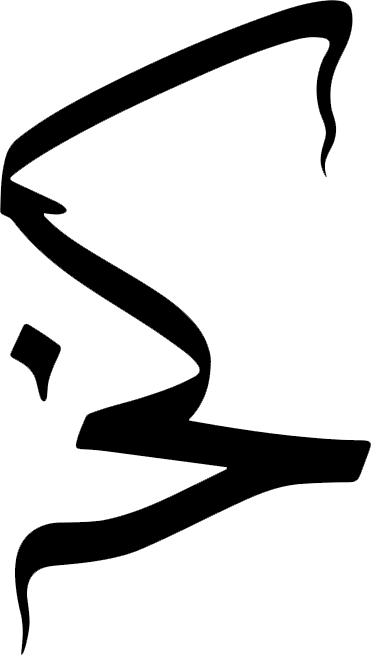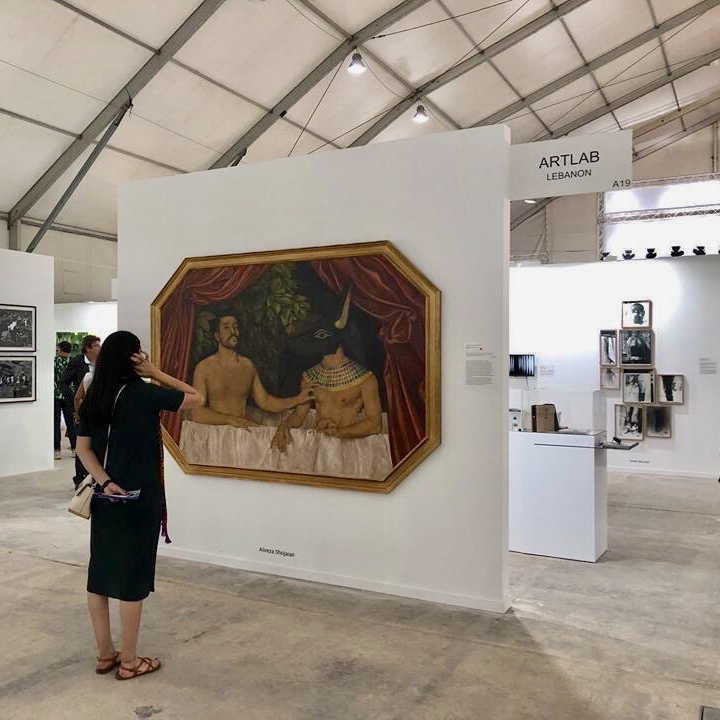Pinched and Prodded
by Lizzy Vartanian Collier
Alireza Shojaian, Hamed Sinno et un de ses Frères, acrylic and colour pencil on wood board, 150 x 220 cm, 2018. Courtesy of artist.
In a painting hung up on a single wall at the heart of this year’s (2018) Beirut Art Fair, Mashrou Leila’s Hamed Sinno sat in a bathtub with the ancient Egyptian god of the afterlife, Anubis. Painted by Beirut-based Iranian artist Alireza Shojaian, Hamed Sinno et un de ses Frères (acrylic and colour pencil on wood board, 150 x 220 cm, 2018) reminded the art fair’s international audience about the events of the band’s concert in Cairo on the 22nd of September, 2017, where many members of the audience were arrested by police for waving the rainbow flag in support of the LGBTQ community.
Unknown, Gabrielle d’Estrées et une de ses sœurs, oil on wood, 96 x 125 cm, circa 1594. Wikicommons.
Shojaian’s image heavily references a late sixteenth-century French painting by an unknown artist titled Gabrielle d’Estrées et une de ses sœurs (oil on wood, 96 x 125 cm, circa 1594), which depicts the pregnant mistress of King Henry IV of France sitting nude in a bath, holding the King’s ring. Besides her is another woman, her sister, pinching Gabrielle’s right nipple. In Shojaian’s painting, Anubis replaces Gabrielle, while Sinno pinches the deity’s nipple. Instead of a ring, Anubis holds an ankh, the ancient Egyptian symbol of immortality. “Whatever powers do to stop someone involved with this activism, they give more power and immortality to them,” explains Shojaian of the ankh. “But the future is always pregnant with whatever we’re doing now, with the hope that the future is going to deliver better days and freedom,” he adds. In addition to the ankh, the background of Shojaian’s painting differs from original, with a tree and a fountain symbolizing the growth of the tolerance movement throughout the Middle East.” It is an appropriate coincidence that the collar around Anubis’s neck reflects the colors of the rainbow flags waved during the concert in Cairo, which is how the God is often depicted in ancient Egyptian paintings. To complete the parallel, Anubis and Sinno subtly wear matching earrings, mimicking those worn by Gabrielle and her sister.
One year after the arrests, Shojaian exhibited the painting alongside a quote written by English art critic John Berger in 2005 that read:
“I can’t tell you what art does and how it does it, but I know that art has often judged the judges, pleaded revenge to the innocent and shown to the future what the past has suffered, so that it has never been forgotten.”
Mashrou Leila concert in Egypt, 22nd of September, 2017. Jamal Saidi/Reuters. PRI.
While an international visitor to the fair may not have recognized the significance of the statement, the majority of Lebanese or Arab viewers would. Mashrou Leila—formed in 2008 at the American University of Beirut—is one of the best-known bands from the region, with Hamed Sinno being openly gay and a strong, inspiring advocate for LGBT rights both in the Middle East and across the globe. While the Arab press acknowledged the arrests in Egypt, it failed to foster lasting attention. “Why now? After a year?” explains Shojaian, “Because everyone talked about this event for a couple of weeks and then forgot about it—except those who suffered; it changed their lives. It’s not just going to the police station and coming home. You have to deal with a conservative family that might refuse you at home. This reaction is common, especially in the Middle East. It’s why I always try to open a dialogue with society through art, to open all the issues besides the main one.” In fact, in the same way that the Mashrou Leila concert arrests in Cairo were glossed over, so was Shojaian at the Beirut Art Fair, who reached out to me because of the lack of press attention his work received within the Arab world. “Honestly I was expecting more feedback in the Middle East,” he explained, “But only Switzerland saw my project. The message is for the Middle East and not there. This article [in the Swiss publication Neue Zürcher Zeitung] was available in a place where sexual identity is not a big issue—at least people don’t suffer there because of it. Here, nobody talks about it, and we all know how much our society needs to be informed about this subject.”
At the fair, the reactions to the painting were positive, and so was the response from Mashrou Leila’s front man, who was sorry when it was refused by the Sursock Museum but pleased it was eventually exhibited at the alternate venue. “I contacted Hamed and offered him to pose for this project to document the concert in Egypt, which I knew he was very sad about,” says Shojaian about approaching the musician about the painting. Shojaian created the image from a photograph he shot with him, and the painting took two months of almost 10-hour long workdays. Artlab—which, three years ago, accepted Shojaian’s portfolio after having been ignored by most Beirut galleries—even closed one of their spaces so that he could work on the project.
The exhibition of such a painting at an art fair may seem strange. In the Middle East, especially where censorship is high, art fairs are generally not venues for exposure to political and social issues. But, despite the trials accompanying controversial art, Shojaian didn’t stop trying. “I initially tried submitting this project for the open call of Sursock Museum’s Salon d’Automne, which would have been a chance to have the artwork on display for three months in a renowned museum space in Beirut,” explained Shojaian. In fact, he didn’t initially mean for the work to be on display at Beirut Art Fair. “Unfortunately,” he says, “two evenings before the opening of the Beirut Art Fair, I received the news that the work was refused by the Salon d’Automne’s second jury.” The result, which was given without any explanation or reasoning, was devastating for Shojaian, who desired the chance of exhibiting his piece: “I couldn’t stop crying the whole night, especially since a homophobe assaulted my friend in Beirut the very same day.” Despite the setbacks, his gallery, Artlab Beirut, changed their set-up at the fair to accommodate the painting.
Alireza Shojaian, The Perfect Moment, acrylic and color pencil on wood board, 105 x 120 cm, 2017. Courtesy of artist.
That being said, this was not the first time that Shojaian exhibited a work that touched on homosexuality during the Beirut Art Fair. During the fair’s 2017 edition, Shojaian, also with Artlab, exhibited The Perfect Moment (acrylic and color pencil on wood board, 105 x 120 cm, 2017), which referenced Robert Mapplethorpe’s final exhibition in Washington D.C. during September, 1989. In the 2017 painting, Shojaian references the openly gay American photographer’s Two Men Dancing (Gelatin silver print, 48.5 x 38.6 cm, 1984), incorporating Khansa, a Lebanese dancer and performance artist, as one of the characters. Mapplethorpe’s exhibition was understood to be “promoting homosexuality,” which led to protests and eventually the closure of the show. Fortunately, Shojaian’s paintings have not been so divisive when exhibited. While his images may be seen as too controversial or daring, they have actually succeeded in crushing stereotypes about what can and cannot be exhibited in Lebanon. “One of the European galleries was not sure if Beirut was open enough to exhibit their photographs,” he explained. “But after seeing my work in Artlab’s stand, they decided to exhibit that photograph.”
Hamed Sinno et un de ses Frères was sold before Beirut Art Fair’s opening, but Shojaian is happy to report that the collector promised to exhibit the painting as soon as they could find a public collection in which to do so. “Being an emerging artist is difficult anywhere,” acknowledges Shojaian, “Tehran, Beirut, or elsewhere. I think that in Lebanon, the LGBTQ community enjoys more tolerance, yet we are still at the forefront of the battle for basic sexual identity rights.” The painting was made to be seen, to bring visibility to the LGBTQ community, and Shojaian continues to fight for his community’s rights. “I believe a painting has the potential to keep the history alive,” he says. “This is why I usually try to capture the memories and real stories of our time.”
Lizzy Vartanian Collier is a London-based writer with a special interest in contemporary Middle Eastern Art. She has a BA in Art History and an MA in Contemporary Art and Art Theory of Asia and Africa from the School of Oriental and African Studies. She runs the Gallery Girl blog and has written for After Nyne, Arteviste, Canvas Magazine, Harper's Bazaar Arabia, Ibraaz, Jdeed Magazine,ReOrient, and Suitcase Magazine. Lizzy is also curator of Arab Women Artists Now - AWAN 2018 (London).






